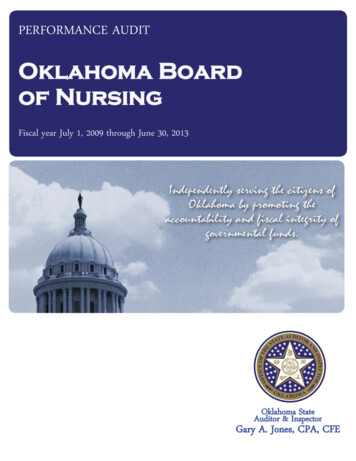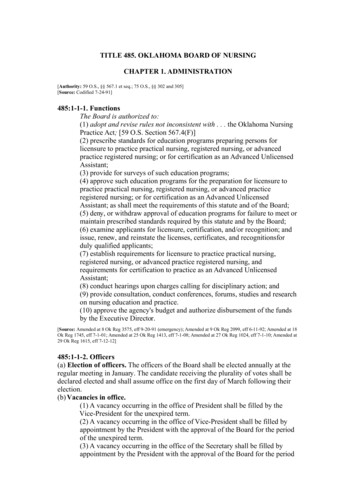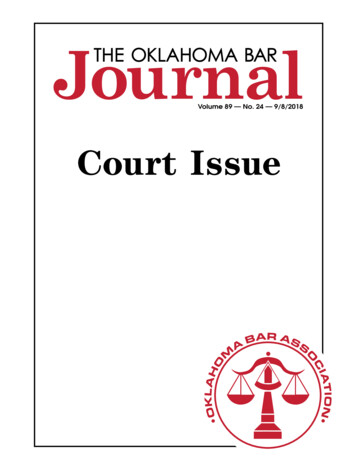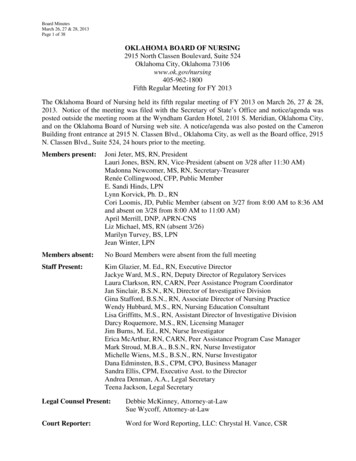
Transcription
PERFORMANCE AUDITOklahoma Boardof NursingFiscal year July 1, 2009 through June 30, 2013Oklahoma StateAuditor & InspectorGary A. Jones, CPA, CFE
Audit Report of theBoard of NursingFor the PeriodJuly 1, 2009 through June 30, 2013This publication, issued by the Oklahoma State Auditor and Inspector’s Office as authorized by 74 O.S. § 213.2 B., hasnot been printed, but is available on the agency’s website (www.sai.ok.gov) and in the Oklahoma Department ofLibraries Publications Clearinghouse Digital Collection, pursuant to 74 O.S. § 3105.B.
September 23, 2013TO THE OKLAHOMA BOARD OF NURSING AND CITIZENS OF OKLAHOMAThe Oklahoma Board of Nursing (OBN) appears to be led by capable management, demonstratinghigh standards and a proactive approach. This state agency elected to consolidate its informationtechnology (IT) services with the Information Services Division of the Office of ManagementEnterprise Services (OMES ISD) with the goal of better securing its IT resources and to serve as anexample for other self-sustaining state agencies that choose to consolidate.Our audit of the Board of Nursing shows that OMES ISD has not met its IT service qualityobligations to this agency such as reliable access, timely responses and resolutions to help deskrequests, and guaranteed updates to agency IT policies and disaster recovery plans. The extent ofthese service standard deficiencies was illustrated when several unauthorized OBN employees wereinexplicably granted access to secured files, creating the opportunity for a security breach of licenseeinformation and undermining agency policies.Management is concerned with the written OMES ISD agreement and overall communication withOMES ISD staff. Moreover, instead of reducing costs, the consolidation has actually increasedrelated IT expenses by 14% from FY 2011 to FY 2013. Similar concerns were raised in a recent Senatesubcommittee report, recounting complaints of increased costs and frustrations in other IT serviceconsolidated state agencies.Our objective examination suggests that if OMES ISD was a private vendor, the substandard servicelevel provided to OBN quite possibly would result in termination of the IT service agreement. If theBoard and agency management opt to continue the agreement, the responsibility to correct servicequality deficiencies clearly rests with OMES ISD.As all current IT consolidated state agencies could benefit from appropriate improvements in OMESISD service quality, prospective candidates would be well served to carefully consider this audit, asOBN’s experience does not appear to be an isolated case.From a broader perspective, current and future OMES ISD users would gain from an independentperformance audit to validate that quality performance measures are developed and maintained andthat progress toward achieving the stated IT consolidation goals of increasing the effectiveness andefficiency of the state’s technology services is meeting expectations.An unbiased evaluation of the IT consolidation process will provide transparency and accountabilityof the initiative’s true progress and will determine if the related legislative policies are producing theintended results.Sincerely,GARY A. JONES, CPA, CFEOKLAHOMA STATE AUDITOR & INSPECTOR
Board of NursingPerformance AuditBackgroundThe mission of the Oklahoma Board of Nursing (the Agency) is tosafeguard the public's health, safety, and welfare through the regulationof nursing practice and nursing education. The Agency is responsible forregulating the practice of nursing and establishing minimum standardsfor education programs, and is self-sustaining through collection oflicensing and renewal fees.Oversight is provided by a board of eleven members (the Board): sixregistered nurses, three practical nurses, and two members representingthe public, all appointed by the governor.Board members as of August 2013 are:Joni Jeter, RN, MS . PresidentLauri Jones, RN, BSN. Vice-PresidentMadonna Newcomer, RN, MS, NE-BC. Secretary/TreasurerApril Merrill, APRN-CNS, DNP . MemberLynn Korvick, RN, PhD, CNE . MemberJana Martin, RN, MS, CNE . MemberJean Winter, LPN . MemberMarilyn Turvey, LPN, BS . MemberSandi Hinds, LPN, MBEC . MemberRenee Collingwood, CFP . Public MemberCori Loomis, JD . Public MemberTable 1 summarizes the Agency’s sources and uses of funds for statefiscal years 2011 and 2012 (July 1, 2010 through June 30, 2012).Table 1 - Sources and Uses of Funds for SFY 2012 and SFY 201120122011Sources:Nursing Registration License/Fee Other Fines, Forfeits, Penalties 256,429.96Other (Cost Recovery and Refunds)Total 413.80 3,073,579.35 3,075,656.52 2,035,382.68 1,960,081.38Uses:Personnel ServicesProfessional Services530,163.96531,601.27Miscellaneous ,880.59Travel63,970.7165,212.0859,486.98Office Furniture and Equipment46,171.65Maintenance and Repair30,634.8352,183.04General Operating30,913.6741,507.93Other1,022.60Total Uses 3,009,338.441,171.57 3,020,778.83Source: Oklahoma PeopleSoft Accounting System (unaudited, for informational purposes only)1
Board of NursingPerformance AuditScope andMethodologyThis audit was conducted at management’s request in accordance with 74O.S. § 213.2.B.We conducted this performance audit in accordance with generallyaccepted government auditing standards. Those standards require thatwe plan and perform the audit to obtain sufficient, appropriate evidenceto provide a reasonable basis for our findings and conclusions based onour audit objectives. We believe that the evidence obtained provides areasonable basis for our findings and conclusions based on our auditobjectives.In planning and conducting objective I of our audit, we focused on themajor financial-related areas of operations based on assessment ofmateriality and risk for the period July 1, 2009 through June 30, 2012. Ouraudit procedures included inquiries of appropriate personnel, inspectionsof documents and records, and observations of the Board of Nursing’soperations. We also tested a sample of transactions to achieve ourobjective.To ensure the samples were representative of the population andprovided sufficient, appropriate evidence, the random samplemethodology was used. We identified specific attributes for testing eachof the samples and when appropriate, we projected our results to thepopulation. Additional methodology and an alternate audit periodrelated to objective II are discussed later in the report.Because of the inherent limitations of an audit, combined with theinherent limitations of internal control, errors or fraud may occur and notbe detected. Also, projections of any evaluation of internal control tofuture periods are subject to the risk that conditions may change orcompliance with policies and procedures may deteriorate.OBJECTIVE IConclusionDetermine whether the Agency’s internal controls provide reasonableassurance that revenues and expenditures (including payroll) wereaccurately reported in the accounting records, and financial operationscomplied with 62 O.S. § 211, 74 O.S. § 3601.2.A, and 59 O.S. § 567.4.F.The Agency’s internal controls provide reasonable assurance thatrevenues and expenditures (including payroll) were accurately reportedin the accounting records.2
Board of NursingPerformance AuditFinancial operations complied with the following statues: 62 O.S. § 211 – 10% of gross fees charged, collected, and receivedwere transferred to the state general revenue fund as required bystatute. 74 O.S. § 3601.2.A – executive director’s salary does not exceed themaximum set forth in state statute. 59 O.S. § 567.4.F – board member meeting stipends are paid inaccordance with state statute.No exceptions were noted as a result of our procedures.OBJECTIVE IIDetermine whether the Agency’s Information Technology consolidationprocess complied with certain components of its Service LevelAgreement, and identify potential opportunities for vendor serviceimprovements.In 2011, the Information Technology Consolidation and Coordination Act(HB 1304) charged Oklahoma’s chief information officer with increasingthe effectiveness and efficiency of the state’s technology services byconsolidating all information technology (IT) services and personnel intoa single department, through the Office of Management EnterpriseServices, Information Services Division (OMES ISD). This mandateapplied to agencies whose revenues are appropriated by the legislature.As a self-sustaining agency that does not receive appropriations, theBoard of Nursing elected to participate in IT consolidation.The Agency’s reasons for volunteering to consolidate included thefollowing objectives: Improved security of data and equipment in case of a disaster (asthe server would now be housed at OMES ISD)Improved continuity of business in case of disasterHandling of IT contracts by a more experienced, expert, andcontinuous staffThe chance to serve as a model for other agencies who mightvolunteer to consolidatePlanning for consolidation of the Agency began in October 2011.Implementation occurred in January 2012 and included most IT servicesother than telephone. The Agency also retained possession of the majorityof its equipment, such as desktop and laptop computers.3
Board of NursingPerformance AuditDuring the consolidation process and in the time that has elapsed sinceconsolidation, management has experienced issues regarding the qualityand reliability of service received from OMES ISD. In this section we willaddress significant areas of the Agency’s written agreement with OMESISD as well as management’s other concerns, followed by our conclusionand recommendations.MethodologyTo accomplish our objective, we performed the following: Developed an understanding of the Agency’s InformationTechnology consolidation process, services provided by OMESISD, and related management considerations, through discussionwith Agency management and staff, discussion with OMES ISDstaff, and review of documentation. Reviewed the Service Level Agreement (SLA) between the Agencyand OMES ISD and identified significant aspects of the agreement.This is the main agreement governing IT services provided as aresult of consolidation. Because the language in these agreementschanged significantly from FY 2012 to FY 2013, we have includeddetails on both documents in our observations. Assessed the significant aspects of the SLA to determinecompliance with those aspects and overall adequacy of theagreement. This included analyzing all help desk ticketssubmitted by the Agency from consolidation in January 2012through June 2013. (Note that help desk data was provided byOMES ISD and Board of Nursing staff and is those agencies’representation of the full body of help desk ticket data for theAgency.) Reviewed the Consolidation Plan developed by OMES ISD toimplement the consolidation, identified key topics, and reviewedthese topics along with significant SLA provisions. Compared relevant Agency IT costs in FY 2011 and FY 2013 todetermine whether consolidation appears to have been in thefinancial best interest of the Agency (related to identifyingopportunities for potential improvements). Compiled and considered management’s remaining issues notrelated to provisions of written agreements.4
Board of NursingPerformance AuditCompliance with Agency-Vendor Service Level AgreementUptime andReliabilityThe FY 2012 service-level agreement (SLA) between the Agency andOMES ISD states that OMES ISD will provide reliable and secure accessto networks, file and print services, and e-mail services, with 99% uptime.The FY 2013 SLA mentions these same services, but excludes thestatistical guarantee. Because OMES ISD does not have a method in placeto track uptime, we interpreted the SLA language to mean generally thatOMES ISD promises to be “very reliable.” Board of Nursing managementdoes not believe the Agency receives “very reliable” uptime based uponconnectivity problems Agency employees have experienced.We reviewed all help desk tickets for the Board of Nursing sinceconsolidation occurred (January 2012 through June 2013) and noted avariety of uptime and access-related issues reported by Board of Nursingstaff. These included issues related to accessing the AS400 databasesystem, PeopleSoft (the state’s accounting system), the Agency’s network,the internet, and e-mail, as well as unique issues such as trouble withlogins and specific software access problems. Overall, in 651 help desktickets we identified at least 84 access issues. These issues sometimesaffected multiple people and took varying lengths of time to resolve. Itstands to reason that anyone using IT services will have occasional accessproblems or questions, but overall it appears the Nursing Board staffexperienced a variety of access issues.Because these cases take varying lengths of time to resolve, quantifying“uptime” is difficult. If we consider each year to have 260 working days,and assume that consolidation began January 1, 2012 and is examinedthrough June 30, 2013, we see at least 84 access issues in 390 work days, oran access issue on 21.5% of work days. It appears OMES ISD has not beenproviding reliable access as indicated in the SLA.Help DeskServiceThe consolidation plan developed by OMES ISD for the Board ofNursing’s consolidation explains that help desk staff is expected to close62% of issues on its own, so Agency administrative staff is freed of theseduties. The FY 2013 SLA also includes the 62% first-contact closure target.Agency management is concerned that help desk responses and handlingof help desk tickets are slow and, at times, inefficient. OMES ISD has adashboard system in place and available online that illustrates itsperformance in relation to various targets outlined in their recent service-5
Board of NursingPerformance Auditlevel agreements (including response and resolution times for varioushelp desk case priority levels). The following are statistics from thatdashboard on the number of help desk cases closed on first contact forJanuary 2012 through June 2013. 1 According to OMES ISD, this data isdrawn from the PeopleSoft system used by help desk staff to track cases.Oklahoma Board of Nursing:Overall for State Agencies:With regard to state agencies overall and the Nursing Boardspecifically, it appears that help desk staff is not able to reach its goalof 62% of cases handled by the first contact. One quarter of theAgency’s help desk tickets considered were password resets, whichare generally resolved quickly and should help bolster the 62% figure.OMES ISD staff members suggested these metrics and overall problemsolving response time suffer when new agencies are consolidated,increasing help desk workload, and indicated that help desk employeeturnover may contribute to the problem. Moreover, OMES ISD plans tocontinue adding agencies, which could place additional strain on theirlimited resources.According to its HB 1304 Quarterly Progress Report on Consolidation,dated January 31, 2013, OMES ISD plans to consolidate the followingagencies in FY 2014: 2OMES CIO website, Operations Service-Level Dashboard, accessed dll?Dashboard.2 OMES CIO website, HB 1304 Quarterly Report, FY-2013 Year 2, Quarter 2, page 1-14, accessed 07/16/13;http://www.ok.gov/cio.16
Board of NursingPerformance AuditWhile the consolidation plan suggests that OMES ISD services areintended to free agency administrators of IT-related duties, Board ofNursing management estimates that the time spent on IT issues hasactually increased, due to the fact that staff must not only submit helpdesk tickets but often must monitor issues to ensure they are promptlyand appropriately managed.Management also expressed a concern that Agency staff has difficultyverifying that work requested from OMES ISD has been completed. Weidentified four examples of help desk tickets closed before resolution.However, it is possible that more cases exist, as help desk tickets that areclosed prematurely are often reopened rather than creating a new ticket.This practice makes it difficult to identify initially unresolved cases inarchived help desk records. OMES ISD staff explained that this issue isnot unique to the Board of Nursing and OMES ISD is attempting toaddress the issue for all customers.As discussed in more detail in the next section, we found numerous casesfor which the OMES ISD response and resolution time periods did notmeet the response and resolution periods promised by the SLA.7
Board of NursingPerformance AuditIt appears OMES ISD is not meeting its obligation to close 62% of helpdesk cases on first contact and OMES ISD responses to help desk requestsand resolutions of those requests are not reliably on-time. In addition,Agency administrative staff members do not believe they are freed of ITrelated duties, and lack assurance that all IT questions or concerns havebeen addressed when the related help desk tickets are closed.PriorityClassificationand TimelinessHelp desk cases submitted by the Agency are ranked according topriority level, and the priority level assigned determines how timely deskstaff is intended to respond to Agency personnel and resolve the issue.The FY 2012 SLA, FY 2013 SLA, and consolidation plan all addresspriority ranking of help desk cases. The following is a summary of thepriority levels and associated goal time periods for response (when theassigned help desk employee responds to the Agency’s open help deskticket) and resolution (when the Agency’s IT problem is fully resolved):Priority 1 (high)Priority 2 (medium)Priority 3 (low)RoutinePasswordResponse90% of responseswithin 15 minutes85% of responseswithin 2 hours85% of responseswithin 24 hours85% of responseswithin 1 business day90% of responseswithin 10 minutesResolution90% of resolutionswithin 2 hours85% of resolutionswithin 4 hours85% of resolutionswithin 7 days85% of resolutionswithin 5 business days90% of resolutionswithin 20 minutesAgency management expressed concerns that some help desk requestsmay be ranked too low in priority. During our analysis of Board ofNursing help desk tickets we were unable to conduct an exhaustivecomparison of all descriptions to priority level assignments, but reviewedthe descriptions of various cases in each of the priority categories andnoted that the priority levels seemed to be generally categorizedappropriately. Because help desk records do not contain detailed, stepby-step descriptions and Agency needs are subjective, our review couldnot capture the complexity of the true process.Using these help desk records, we calculated the time it took for helpdesk staff to respond to the Agency and to resolve reported problems. Wecompared these time periods to the priority-based goal times listed in theSLA and noted that the actual response and resolution times sometimesdid not meet the SLA times:8
Board of NursingPerformance AuditResponseGoal Time Per SLACases Not Meeting GoalPriority 115 minutes18.75%Priority 22 hours0%Priority 324 hours14.00%Routine1 business day19.05%ResolutionGoal Time Per SLACases Not Meeting GoalPriority 12 hours56.25%Priority 24 hours64.71%Priority 37 days26.67%Routine5 business days29.25%(Note that response and resolution are defined on the previous page.)Overall, it appears the anticipated response times and resolution times inthe SLA are not met on a reliable basis. (Password cases are not includedbut are generally completed on time.)We also noted cases for which, according to the help desk system data,the response occurred before the ticket was opened or the case wasresolved before OMES ISD responded to the Agency. These “negativetimes” suggest problems or errors may exist in the data, whether causedby the system or help desk staff.Agency management explained that in order to increase priority statusfor important cases, they sometimes make calls and “back end” requests.OMES ISD staff commented that they are attempting to better educateagencies on including adequate information with their help desk requestsin order to assure that an accurate priority level is initially assigned.Regardless of these explanations, Agency management is currentlyconcerned with the timeliness of services received.PersonalComputingThe FY 2012 SLA states that OMES ISD will provide support foracquisition and implementation of software and one-person systems suchas desktop and laptop computers. The FY 2013 SLA includes workstationsupport and consulting in its list of services. We encountered two issuesrelated to personal computing.In July 2012, the Agency paid for access to SkillSoft, an online e-learningsite provided by OMES Human Capital Management. After two monthsOMES ISD was able to configure Agency computers to access the site.However, the Agency was unable to use the service until January 2013due to difficulties with the state’s internet security system, and was notrefunded the cost of six months in lost training services. According to9
Board of NursingPerformance AuditOMES ISD staff, the Agency was not required to consult with OMES ISDto implement this training system. Because the SkillSoft program wasmarketed and provided by OMES, management expected it would becompatible with the Agency’s IT system. We identified 23 help desktickets related to SkillSoft and the state’s internet security system. OMESISD staff indicated that during this period of time no security officer wasin place, which likely contributed to these issues.The Agency also experienced difficulties and delays in having a computerinstalled to perform federal background checks. Per federal regulations,the computer was required to be isolated from the Agency’s network,with its own internet connection. Repeated help desk tickets weresubmitted to have this computer correctly installed and functional, aprocess which continued in excess of a month. Following this delay,cabling issues were recognized and had to be addressed. We identifiedsix related help desk tickets, all of which were resolved late. Managementdiscussed the Agency’s needs with OMES ISD staff beginning in earlyNovember, and submitted a summary help desk ticket as requested byOMES ISD the same month. It seems some needs were misunderstood,were not adequately communicated, or were not passed on toappropriate personnel. As a result, the Agency missed its plannedimplementation date of January 1, 2013.It appears the Agency has experienced difficulties implementing personalcomputing projects with OMES ISD assistance. While the projects wereeventually completed, management had to spend additional timeworking with OMES ISD staff and monitoring their progress.SecurityThe FY 2012 SLA states that OMES ISD will provide support andinfrastructure to keep Agency data processing equipment and systemsoperational and secure. Security, data center, and server services are alsolisted in the FY 2013 SLA. The consolidation plan states that OMES ISDwill conduct vulnerability scans, policy review, and disaster recoveryplan review and refinement.According to management, Agency employees were grantedinappropriate access to certain files during the consolidation process.While management requested that all file access changes be approved bythe executive director, and OMES ISD staff acknowledged that thisapproval process should have been followed by help desk staff,unapproved file access issues persisted. Using help desk ticket data, weidentified two cases in which employees had unapproved access to files10
Board of NursingPerformance Auditin 2013. Inappropriate employee access could undermine the Agency’sinternal controls and data security, allowing unauthorized staff to read oredit file content such as licensing information, payment details, and socialsecurity numbers. OMES ISD staff was unable to explain whyunapproved employees were allowed access to files.The guaranteed updates to the Agency’s disaster recovery plan and ITrelated policies and procedures have not been completed. OMES ISD staffexplained that disaster recovery plan updates were planned but did notprovide any timeline of when these updates would occur. Thevulnerability scans were conducted.It appears OMES ISD has not met its obligations to ensure the security ofdata in the Agency’s systems or to update related documentation. TheAgency’s electronic files may be susceptible to access by unapprovedinternal parties, with no clear cause. Such inappropriate access couldcompromise the Agency’s controls. OMES ISD has also failed to updatethe Board of Nursing’s policies and disaster recovery plan, possiblyleading to inadequate safeguards and communication in the event of adisaster impacting Agency data or equipment.Back-ups andContractManagementThe FY 2012 SLA states that OMES is responsible for performing backupsof network components and servers it administers. The FY 2013 SLAincludes data center and security services in its list of services.The FY 2012 SLA also states that OMES will provide contract oversightfor the agency’s existing contractor. The FY 2013 SLA outlines AS400related costs, and the Consolidation Plan states that OMES will contractwith Advancia for AS400 server support and for application supportrelated to licensing, investigation, and peer assistance.It appears OMES ISD has met its obligations regarding these provisions.Adequacy of Written AgreementsBoard of Nursing management has discussed various concerns andrequirements with OMES ISD and requested that the results of thosediscussions be placed in a written form such as the SLA. However,management does not believe these discussions have been adequatelydocumented or formulized in writing. Failure to place key approvals andagency-specific information in writing could lead to improper executionor enforcement of important processes.11
Board of NursingPerformance AuditThe lack of documented Agency needs and expectations is compoundedby staffing turnover at OMES ISD. For example, the Agency’s originalcontact separated from OMES ISD in January 2013, and any Agencyspecific information he had learned but not documented may no longerbe available to OMES ISD.Agency management cited two key areas that have not been formallydocumented by OMES ISD, but have been requested of OMES ISD staff: File access and security: Any new file access is supposed to beapproved by the executive director, but this requirement has notbeen formalized.Critical incidents: Nursing management would like OMES ISD todocument what incidents are considered critical to the Agency’soperations, so top priority can be assigned to key problems thatimpede the Agency’s main functions (such as licensing).Formalization of security requirements and agency-specific prioritizationwould likely be important issues for any consolidated agency. During ourinterview, OMES ISD staff noted that the FY 2014 template SLA includesan “Appendix D” which is intended to incorporate these types of agencyspecific needs. However, we reviewed the Board of Nursing’s signed FY2014 SLA and noted that the appendix was not used for this purpose. Theexecutive director stated that she was not informed this was an option.It appears the current written agreements are inadequate from theAgency’s perspective. While a variety of requirements are embodied inthe annual SLA between the Agency and OMES ISD, Board of Nursingmanagement has reasonable needs and expectations beyond the basicinformation in this agreement.Future Aspects of Consolidated ServicesDuring our procedures we learned that OMES ISD plans to move statelicensing agencies to a shared licensing platform called Amanda. OMESISD staff explained that Amanda is a piece of enterprise licensingsoftware intended to replace licensing agencies’ legacy database systemsas they become antiquated. We received mixed information about howwell the platform is working for the few agencies currently using it.OMES ISD staff reported that the system is working well. However,management at one agency using Amanda explained that the agency hadsuffered numerous problems at implementation but is now slowly seeingimprovements.12
Board of NursingPerformance AuditAt the moment, Board of Nursing management has asked that anyprovisions related to Amanda be removed from the Agency’s FY 2014SLA. The Agency, when considering this potential transition to Amandaas a licensing system, should take note that the OMES ISD staffresponsible for the transition is already strained by consolidatingadditional agencies and by employee turnover.Financial EffectsIn order to determine whether IT consolidation has been in the financialbest interest of the Agency, we compared the Agency’s relevant IT costsbefore and after consolidation. Any costs not related to consolidation orOMES ISD services were removed in order to help ensure a faircomparison. For example, because the Agency handles its telephoneservices independently, telephone costs are not included. We alsoexcluded one-time equipment costs, such as purchases of new laptops.Expense CategoryCustom Computer Program ServicesFiscal Year 2011Fiscal Year2013 130,943.06 82,732.162,732.160.00972.00HW Maintenance4,640.1116,038.48SW Maintenance25,432.072,85
Board of Nursing Performance Audit 1 Background The mission of the Oklahoma Board of Nursing (the Agency) is to safeguard the public's health, safety, and welfare through the regulation of nursing practice and nursing education. The Agency is responsible for regulating the practice of nursing and establishing minimum standards










